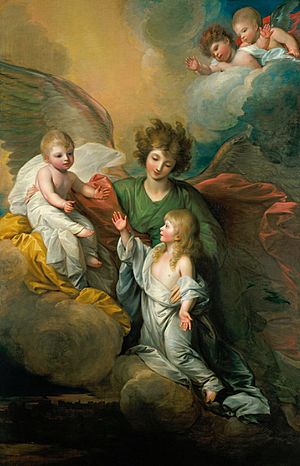Prince Alfred of Great Britain facts for kids
Quick facts for kids Prince Alfred of Great Britain |
|
|---|---|

Portrait by Thomas Gainsborough, 1782
|
|
| Born | 22 September 1780 Windsor Castle, Windsor, Berkshire, England |
| Died | 20 August 1782 (aged 1) Lower Lodge, Windsor Great Park, England |
| Burial | 27 August 1782 Westminster Abbey 11 February 1820 Royal Vault, St George's Chapel, Windsor Castle |
| House | Hanover |
| Father | George III, King of the United Kingdom |
| Mother | Charlotte of Mecklenburg-Strelitz |
Prince Alfred of Great Britain was a young prince who lived a very short life. He was born on September 22, 1780, and passed away on August 20, 1782. He was the fourteenth child of King George III and Queen Charlotte.
Sadly, Alfred was never very strong. He became ill after getting an inoculation for smallpox. His early death, and the death of his brother Prince Octavius a few months later, made his parents very sad. Later in life, King George III would sometimes imagine talking to his two youngest sons.
Contents
A Royal Birth: Prince Alfred's Early Life
Prince Alfred was born at Windsor Castle on September 22, 1780. He was the ninth and youngest son of King George III and Queen Charlotte. This made him a member of the House of Hanover, the royal family at the time.
By the time Alfred was born, his oldest brothers were already grown up. He was baptized on October 21, 1780, at St James's Palace. His godparents were his older siblings: George, Prince of Wales, Prince Frederick, and Charlotte, Princess Royal.
Alfred's birth brought happiness to his family. His older sister, Princess Sophia, was especially fond of him. She even called the new baby her "grandson." From the start, Alfred was a delicate child. He often had skin rashes and a cough.
Battling Smallpox: Prince Alfred's Illness and Passing

In Prince Alfred's time, smallpox was a very dangerous disease. It often caused death for both rich and poor people. There wasn't much medicine to fight it. Later, around 1796, Edward Jenner found a new way to protect people using inoculation.
Queen Charlotte, Alfred's mother, believed strongly in inoculation. She made sure her children received the treatment. In 1782, Prince Alfred was inoculated against smallpox. However, the inoculation made him even sicker.
Alfred developed rashes on his face and eyelids. His chest also became very unwell. In June, he was taken to Deal with his governess, Lady Charlotte Finch, and nurse. Doctors hoped that sea air, bathing, and horseback riding would help him get better.
Lady Charlotte wrote that the sea air seemed to help his appetite. She thought he would get stronger. Alfred was a charming and kind child, and many people liked him. But his spots continued, and his chest problems remained.
By early July, Lady Charlotte thought Alfred was getting better. But later that month, his health got worse. He became too weak to walk. In August, Prince Alfred returned to Windsor Castle because he was so ill. Doctors met and sadly concluded he had only weeks left to live.
Prince Alfred suffered from fevers and chest problems. He passed away on August 20, 1782, at Lower Lodge, Windsor Great Park. He was just one month shy of his second birthday.
After Alfred's Death: Family Grief and Legacy
Even though royal children under seven were not officially mourned, Alfred's parents were heartbroken. Queen Charlotte "cried vastly" and was "very much hurt" by her loss. The King was also deeply affected.
The Queen sent Lady Charlotte a locket with a lock of Alfred's hair. It was a thank you for caring for her "dear little Angel Alfred." Alfred was buried at Westminster Abbey on August 27. Later, his remains were moved to St George's Chapel, Windsor Castle in 1820.
Six months after Alfred's death, his older brother Octavius also died from smallpox after inoculation. This was another terrible blow to the King. King George III was even more affected by Octavius's death. He reportedly said, "I am very sorry for Alfred; but had it been Octavius, I should have died too."
Alfred's father continued to think about his sons' deaths. A painting of Alfred by Thomas Gainsborough made his three oldest sisters cry. The King and Queen were also visibly sad. Years later, during one of his illnesses, King George would imagine talking to his two youngest sons.
Prince Alfred was the first of King George III and Queen Charlotte's children to die. His older sister, Princess Mary, was the last of their fifteen children to pass away, in 1857. Alfred was also unique because he never had a younger sibling while he was alive. The only child younger than him was born after his death.
Title and Style: How Prince Alfred Was Addressed
During his short life, Prince Alfred was known as "His Royal Highness The Prince Alfred." He held the title of a Prince of Great Britain and Ireland.
See also
In Spanish: Alfredo de Gran Bretaña para niños

